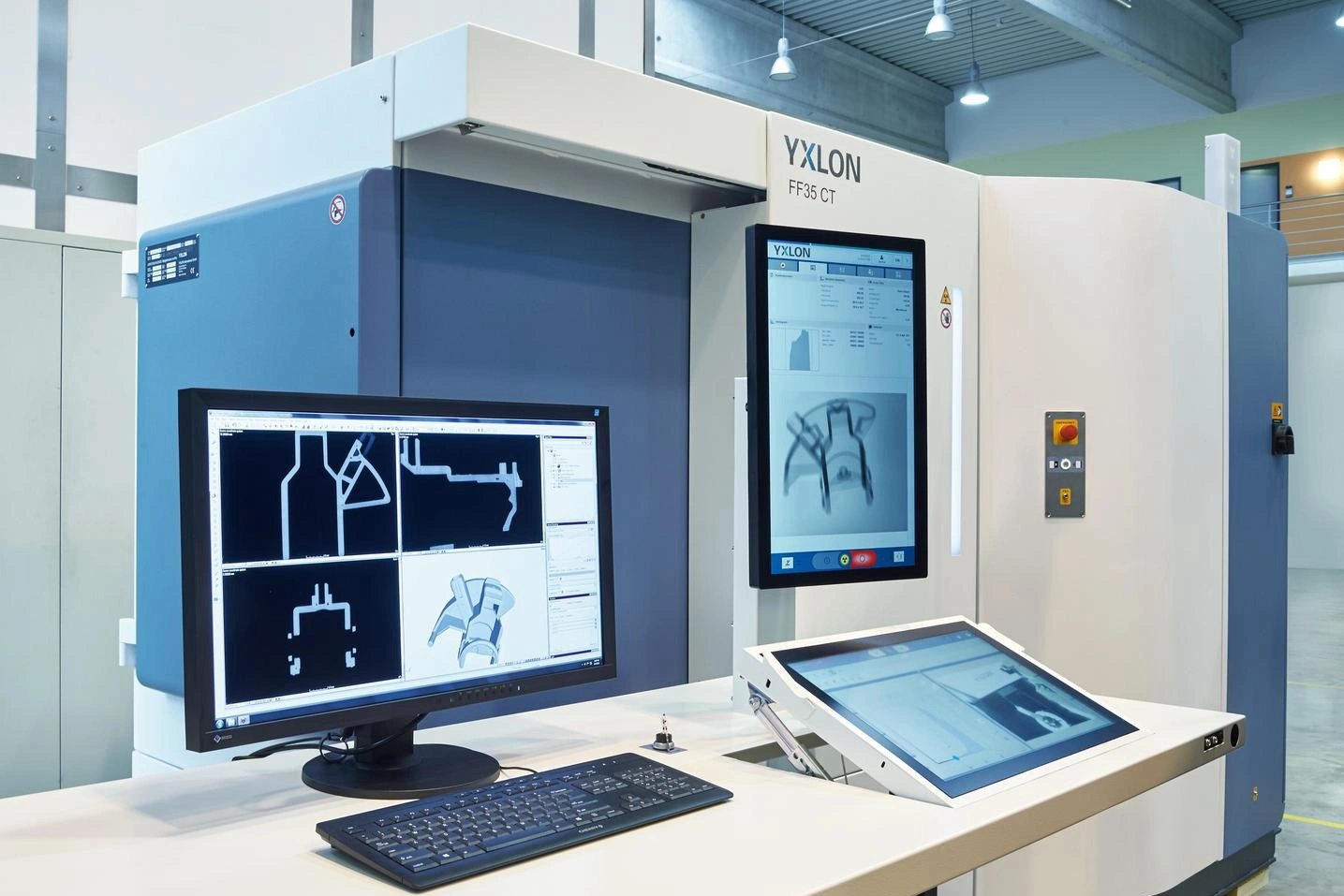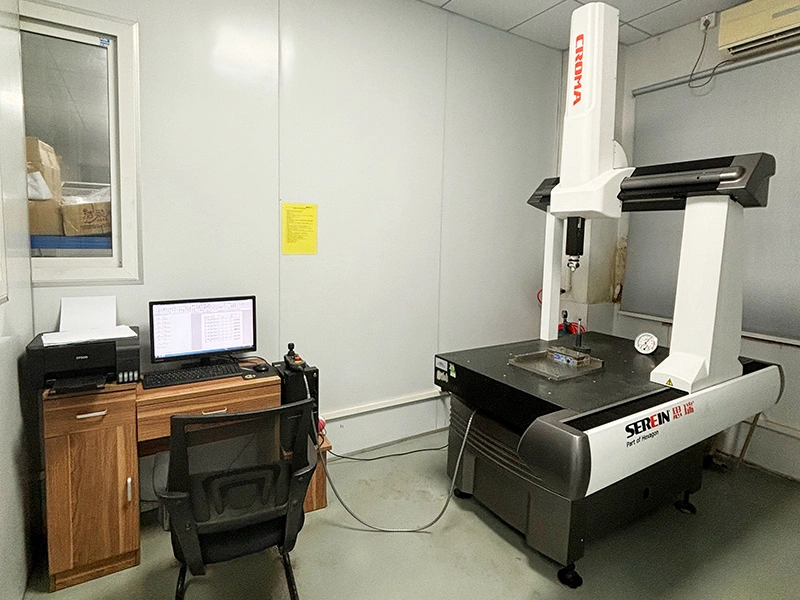450 kV Industrial CT: Full-Volume NDT & Metrology for Complex AM
Introduction: Zero Blind Spots – How 450kV Industrial CT Delivers Full-Volume “X-Ray Health Checks” for Complex AM Parts
As additive manufacturing pushes into aerospace, energy, medical, and defense, one challenge has become painfully clear: we’re printing parts that conventional inspection can’t truly see. As industrial CT engineers at Neway, we routinely work with components that feature internal cooling channels, lattice structures, embedded features, and potential subsurface flaws, which traditional NDT and tactile metrology cannot fully characterize. That’s exactly why we deployed a 450kV industrial CT system. It creates a precise “digital twin” of every inspected part—inside and out—enabling full-volume, non-destructive evaluation and metrology for the most demanding AM geometries.
450kV Industrial CT Technology Overview: Principles & Capability Limits
High-Energy X-Ray and 3D Reconstruction
Our 450kV industrial CT system is built on high-energy X-ray transmission and tomographic reconstruction. During scanning, a 450 kV X-ray beam penetrates the component while the part is rotated, generating hundreds to thousands of 2D projection images. Reconstruction algorithms convert these into a 3D voxel model that represents every internal and external feature of the part. Compared to conventional low-energy CT systems, the 450kV source provides the penetration power required for dense alloys, such as nickel-based superalloys, steel, and even tungsten-based materials, enabling inspection scenarios where standard CT systems fail.
What “Full-Volume” Inspection Really Means
Full-volume CT inspection fundamentally changes the philosophy of quality assurance. Traditional methods capture only surfaces, sections, or sparse sampling points; CT captures the entire internal volume in one dataset. Every voxel can be interrogated: pores, lack of fusion, inclusions, unmelted support, and constricted channels are all visible and measurable. This 100% volumetric visibility is especially critical for high-value AM components, where hidden defects can’t be tolerated and destructive sectioning isn’t an option.
How Neway Integrates 450kV CT into the Quality Workflow for Complex AM Parts
Non-Destructive Detection and Characterization of Internal Defects
For powder bed fusion and other metal AM processes, internal defects are among the top risk factors. With 450kV CT, we can identify and 3D-locate pores, lack-of-fusion regions, hot cracks, keyhole defects, and residual support or unmelted material—even deep inside massive sections. Advanced visualization and analysis enable us to quantify size, morphology, distribution, and defect clustering—data that directly informs fitness-for-service evaluations and process optimization. In many cases, CT replaces traditional destructive metallographic sectioning, achieving a comprehensive understanding while keeping the part intact.
Dimensional Metrology & GD&T on Complex Internal Features
Components with internal lattices, conformal cooling channels, or hidden interfaces usually exceed the capabilities of conventional contact CMM. Using CT-derived 3D volumes, we measure:
Strut diameters and topology of lattice structures
Diameters, wall thickness, position, and curvature of internal channels
Critical interfaces and enclosed features that cannot be probed mechanically
By aligning CT data directly with the CAD model, we perform full GD&T evaluations for both external and internal features within a single, coherent dataset—ideal for AM design validation and production capability studies.
First Article Inspection & Batch Quality Monitoring
For the first article inspection of complex AM parts, 450kV CT provides a fast, exhaustive verification route. A single scan supports:
Internal defect screening
Complete 3D comparison to CAD
Dimensional reporting on critical and hidden features
For serial production, we implement sampling CT strategies for key batches to monitor process stability, detect early drift, and prevent the propagation of systemic defects.
Why 450kV Matters: Key Advantages for AM
Penetration of High-Density Materials
High-energy 450kV X-rays enable reliable imaging through thick sections and dense alloys where low-energy systems suffer from severe attenuation and noise. This is essential for:
Tool steels and martensitic stainless steels
Capability for Large Parts
Our 450kV system offers a generous scanning envelope suitable for many large aerospace and industrial AM structures—such as brackets, housings, casings, and manifolds—providing full-volume inspection without the need for sectioning or complex fixturing workarounds.
High Signal-to-Noise Ratio and Usable Resolution
High penetration does not come at the expense of image quality. With an optimized source-detector configuration and reconstruction, we maintain robust signal-to-noise ratios and fine spatial resolution, enabling the detection and quantification of small internal defects in demanding materials.
“One-Stop” Solution: Unifying NDT and Metrology
From Defect Mapping to Precision Measurement in One Dataset
Industrial CT uniquely allows both NDT and metrology using the same 3D volume. Instead of moving parts between X-ray, CMM, and gauges—with repeated setups and alignment errors—we:
Scan once
Extract voids, inclusions, and anomalies
Perform CAD-to-part deviation mapping and GD&T evaluations
This integrated approach shortens lead times, reduces handling risks, and delivers consistent, traceable results for critical AM parts.
Assembly & Embedded Component Inspection
For AM assemblies or overprinted structures (such as DED/clad parts on cast or wrought substrates), CT evaluates:
Fit and clearance of internal assemblies without disassembly
Interface bonding quality
Presence of gaps, voids, or inclusions at critical joints
This capability is especially valuable when disassembly is impossible or would destroy the component.
Synergy of 450kV CT with Other Inspection Techniques
Complementing Coordinate Measuring Machines (CMM)
We combine CT and CMM for a balanced strategy:
CT for rapid, full-field geometry evaluation (including internal features)
CMM for ultra-high-accuracy verification of key external datums and interfaces
The result: comprehensive coverage plus micron-level confidence where it matters most.
Tiered Relationship with 2D X-Ray
We adopt a tiered NDT approach:
2D X-ray for fast, cost-effective screening of batches
450kV CT for detailed 3D investigation and quantification of suspect parts
This preserves throughput while ensuring deep insight where required.
Precision Targeting for Failure Analysis
Before destructive failure analysis, we CT-scan failed or suspect parts to:
Locate internal cracks, pores, or inclusions
Define precise cut planes for metallography or SEM/EDS
This CT-guided “surgical” approach maximizes information gained from each sample and accelerates root-cause determination.
Case Study: Locating Internal Blockage in an Inconel 718 Fuel Nozzle
In an aerospace engine program, a complex Inconel 718 fuel nozzle with spiral cooling channels exhibited abnormal flow characteristics during testing. Conventional inspection methods were unable to pinpoint the cause.
Using our 450kV CT system, we performed a full-volume scan and reconstructed the internal geometry. The analysis revealed a partially retained support structure at a tight bend in the internal passage, locally constricting the flow area.
With this non-destructive insight, the prototype nozzle was preserved, the root cause was clearly demonstrated, and the customer was able to:
Refine support design
Optimize soluble/support removal and cleaning processes
Subsequent builds passed functional testing without recurrence. This example highlights how high-energy CT closes the loop between design, process, and performance.
Conclusion: Illuminating the Inside to Secure What Matters Most
450kV industrial CT elevates AM quality assurance from partial visibility to true volumetric understanding. It extends our view from outer surfaces into the full internal architecture of complex components, enabling confident use of AM in safety-critical applications. At Neway, we see CT not just as an inspection tool, but as an enabler for smarter design, more robust processes, and verifiable reliability. We welcome developers and manufacturers of complex internal-geometry parts to leverage our CT and metrology capabilities—and turn uncertainty inside your parts into quantified, reportable confidence.
Frequently Asked Questions
What detection accuracy can 450kV industrial CT achieve, maximum applicable part size?
How long does it take to scan a typical part and deliver an analysis report?
How does CT performance differ for plastics, titanium alloys, nickel alloys?
Does CT scanning pose any health risks to operators? What safety measures are in place?
Can you provide formal reports with defect statistics, porosity evaluation color maps?




